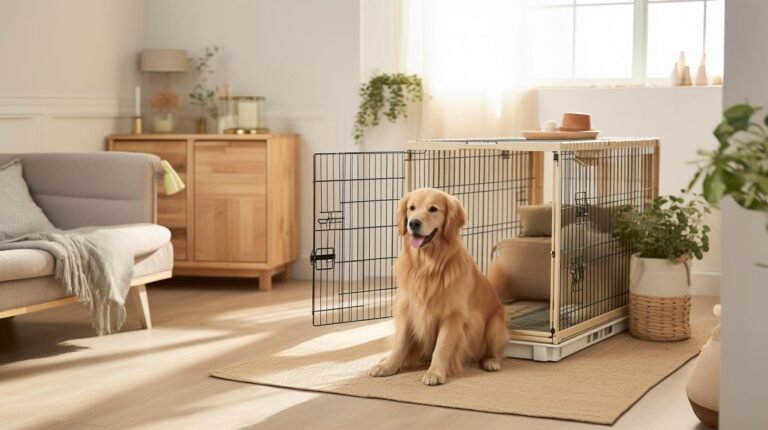Dog owners across the globe are often faced with the dilemma: should I let my four-legged friend sleep in a crate overnight?
The issue of crating dogs often incites a fiery debate amongst pet owners, animal rights activists, and veterinary professionals. Some endorse it as an essential step in puppy training and insist it veils several benefits, while others rebuke it as an inhumane act of confinement. In this comprehensive guide, we will explore the pros and cons, the scientific perspective, and expert advice on having dogs sleep in crates overnight.
Firstly, it’s essential to distinguish that a crate is not, and should not be seen as, a prison for your pup. Instead, think of it as your dog’s cozy bedroom where he can retreat and rest securely. This distinction is crucial, mainly because perception often frames reality. A positive perspective will allow you to use the crate responsibly, ensuring your dog’s comfort and wellbeing while maximizing potential benefits.
Understanding the Crate: A Look Into Your Dog’s Natural Instincts
Training canines to retire to a crate caters to their nature. Understanding your furry friends’ heritage is crucial to discerning why they might actually enjoy a crate. Dogs descended from wolves—creatures that are den animals. These wild ancestors would find small and enclosed spaces to rest, stay safe, and nurture their young. Therefore, contrary to the views of those who condemn it, crating isn’t necessarily against a dog’s instincts. The crate, in many ways, replicates the comfort and security of a natural den.
The Pros of Crating
Let’s shed light on some of the benefits your dog may reap from sleeping in a crate overnight:
1. Potty Training: Dogs don’t like to soil their sleeping areas, which makes crate training an excellent tool for potty training young dogs.
2. Chewing Prevention: An unattended dog, especially a puppy, can get into all sorts of mischief, like chewing furniture. A crate prevents this from happening when you’re asleep and unable to supervise them.
3. Reduced Anxiety: For many dogs, a crate is a sanctuary. It provides a sense of security and privacy, which can help reduce anxiety, especially in new environments.
4. Safety: Crates are a safety precaution during travels or in emergency situations. It gets the dog accustomed to a confined space without causing fear or discomfort.
5. Time-Out: For households with children or other animals, a crate can serve as a quiet space where your pooch can relax undisturbed.
However, these benefits hinge on two vital aspects: first, the crate must be a comfortable space; second, it should never be a place for punishment.
The Downside to Crating
While occasional and properly managed crating can have benefits, prolonged and excessive use can lead to problems:
1. Health Risks: A dog that is regularly crated for long hours can suffer from physical health problems like muscle degeneration due to lack of exercise and obesity. It can also lead to mental health problems like severe anxiety and depression.
2. Behavioral Issues: Dogs require social interaction and exercise for holistic growth and development. Dogs confined in crates for extended periods can display behavioral problems like hyperactivity, aggression, and fearfulness.
3. Dependency: Incorrect use of a crate can make a dog overly dependent on it. This could be an issue, especially when travel or other situations make the crate unavailable.
4. Unethical Usage: Some pet owners misuse crates, using them as a way to avoid interacting with their pet or dealing with behavioural issues. This is not only unethical but also cruel to the animal.
Scientific Perspective and Expert Advice
Dr. Lisa Radosta, a Board-Certified Veterinary Behaviorist, says, “It’s not cruel to crate dogs overnight. Dogs in the wild would be sleeping in a small den, so the crate serves as that den.” However, she stipulates that the crate must be a haven, not a jail cell.
The American Kennel Club (AKC) also advocates crate training for dogs, identifying it as an excellent method to keep puppies safe, minimize destructive behavior, reduce anxiety, and assist with toilet training.
Final Thoughts
Whether you should let your dog sleep in a crate overnight should depend on your pet’s individual needs, behavior, and comfort. No one-size-fits-all solution suits every dog. It’s crucial to observe your pup, understand their behavioral signs, and make a decision in their best interest.
If you choose to crate, do it responsibly. Ensure the crate is comfortable, welcoming, and the right size for your dog. Remember, the crate shouldn’t replace a significant portion of their daily exercise, social interaction, and roaming time. And importantly, the crate should NEVER be used as a punishment tool.
Crating is a tool, not a lifestyle. Balancing crate time with ample outdoor recreation, socialization, and freedom is crucial for a happy, well-adjusted, and healthy pet. Always put your pet’s welfare at the forefront of every decision you make as a responsible and loving pet parent.



